What is a Flash Flood? Causes, Impacts, and Safety Tips You Need to Know
What is a flash flood? What should you do in the face of flash flooding? Keep reading this post to get all the necessary information about this devastating natural disaster. You will be surprised at the greatest threat to life and limb of a flash flood.

What is flash flooding?
What is a flash flood?
A flash flood is a very quick rise of water along a stream or low-point urban area. It is caused by heavy or excessive precipitation from hurricanes and thunderstorms in a short time ( generally within 3 - 6 hours).
A flash flood can also occur as a result of a dam failure or rapid ice melt. It often begins with little to no warning and can quickly intensify, producing strong currents capable of sweeping away cars and other debris.
Characteristics of flash floods
-
Rapid speed: Flash floods can happen within minutes of intense rain or other triggering events.
-
Localized impact: They often affect small areas such as narrow valleys, urban streets, or low-lying regions.
-
High water velocity: Flash floods produce fast-moving water that can sweep away people, vehicles, and structures.
-
Danger: Flash floods are among the most deadly types of floods due to their speed and power, catching people off guard.
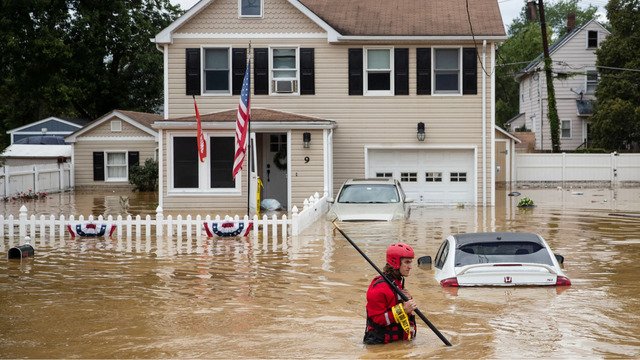
Fast-moving water of a flash flood can sweep away anything on its road
Difference between a flash flood vs flood
While both flash floods and regular floods involve an overflow of water onto normally dry land, they differ significantly in their speed, causes, and duration.
|
Aspect |
Flash Flood |
Regular Flood |
|
Speed of onset |
Occurs suddenly, typically within minutes to 6 hours after heavy or intense rainfall or sudden water release. |
Develops gradually over hours, days, or even weeks due to steady rainfall, snowmelt, or river overflow. |
|
Duration |
Short-lived, usually lasting a few hours. |
Can last for days or weeks, covering large areas. |
|
Cause |
Heavy localized rain, dam or levee failure, rapid runoff in urban areas or steep terrain. |
Prolonged rain, snowmelt, upstream water release, or saturated ground conditions. |
|
Warning time |
Very little warning; can happen with little notice, making it more dangerous. |
More warning time, allowing for evacuation and preparation. |
|
Impact |
Fast-moving, high-velocity water can cause rapid destruction, especially in urban or narrow valleys. |
Slower rising water can cause widespread flooding over larger regions. |
|
Examples |
Sudden flooding of streets, riverbeds, or canyons after intense storms. |
River flooding due to prolonged rain or melting snow, widespread regional flooding. |
Difference between a flash flood vs storm surge
Flash floods and storm surges are both hazardous types of flooding, but they differ significantly in their causes, locations, and characteristics.
Take a look at this table to see how difference between a flash flood and storm surge.
|
Aspect |
Flash Flood |
Storm Surge |
|
Cause |
Intense rainfall, dam failure, rapid snowmelt |
Strong coastal storms (hurricanes, cyclones) |
|
Location |
Inland areas, rivers, valleys, and urban regions |
Coastal areas and shorelines |
|
Onset |
Suddenly, minutes to hours |
Gradual, hours to days |
|
Duration |
Short-lived (minutes to hours) |
Longer-lasting (hours to days) |
|
Scale |
Localized, limited area |
Widespread coastal flooding |
|
Predictability |
Difficult to predict, little warning |
More predictable with advance warnings |
|
Water Source |
Rainwater or freshwater from rivers/dams |
Seawater pushed inland by wind and pressure |
|
Damage Type |
Rapid, intense destruction, flash currents |
Coastal inundation, erosion, and storm damage |
|
Risk Areas |
Inland communities, urban and rural areas |
Coastal towns, cities, and infrastructure |
This comparison highlights the key differences to help understand and prepare for these distinct flooding hazards.
What causes flash floods?
The most common cause of a flash flood is intense rainfall in a short time. However, in fact, there are still several factors leading to these sudden natural events.
They are:
-
Heavy Rainstorms: Intense rainfall, especially from localized thunderstorms, can drop large amounts of rain in a very short time. This sudden influx of water often overwhelms both natural soil absorption and man-made drainage systems, leading to rapid flooding.
-
Dam or Levee Failure: When a dam or levee breaks, it releases a massive volume of water abruptly, creating an artificial surge downstream that can cause sudden flooding.
-
Rapid Snowmelt: A quick rise in temperature or rain falling on snow can cause the snowpack to melt rapidly. This sharp increase in runoff sends large amounts of water into rivers and streams, triggering flash floods.
-
Ice or Debris Jams: Rivers or streams can become blocked by ice or debris, causing water to back up. When the blockage suddenly clears, the accumulated water rushes downstream, causing flash flooding.
-
Burn Scars from Wildfires: Areas recently affected by wildfires have reduced vegetation and altered soil properties, which decrease their ability to absorb water. This leads to increased runoff and erosion during heavy rains, creating ideal conditions for flash floods.
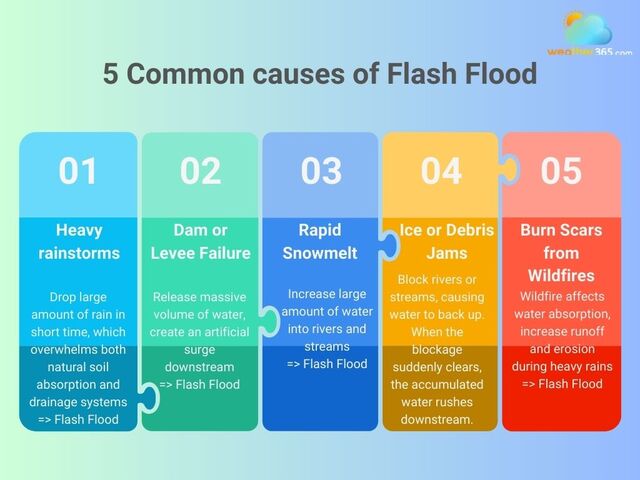
Common causes of flash floods
Where do flash floods occur?
Flash floods can happen almost anywhere, but certain areas are especially prone due to their geography, land use, and infrastructure.
-
Urban Areas: Cities and towns face a high risk because paved surfaces and buildings prevent water from soaking into the ground. Storm drains can quickly become overwhelmed during sudden, intense downpours.
-
Low-Lying Regions: Naturally, valleys, basins, and flood plains collect water. This makes them susceptible to rapid flooding during heavy rains.
-
Mountainous Terrain: Rainwater flows swiftly down steep slopes, funneling into narrow valleys and stream channels where it can accumulate rapidly.
-
Arid and Semi-Arid Regions: In dry climates, soil often struggles to absorb water quickly. Thus, a short but intense storm can cause strong runoff, despite long dry periods.
Areas that don’t usually experience flooding can still become vulnerable if conditions align.
Factors such as local topography, land development, and recent weather patterns all play a role in flash flood risk.
Also, you can find out which US states often have floods. Read here!
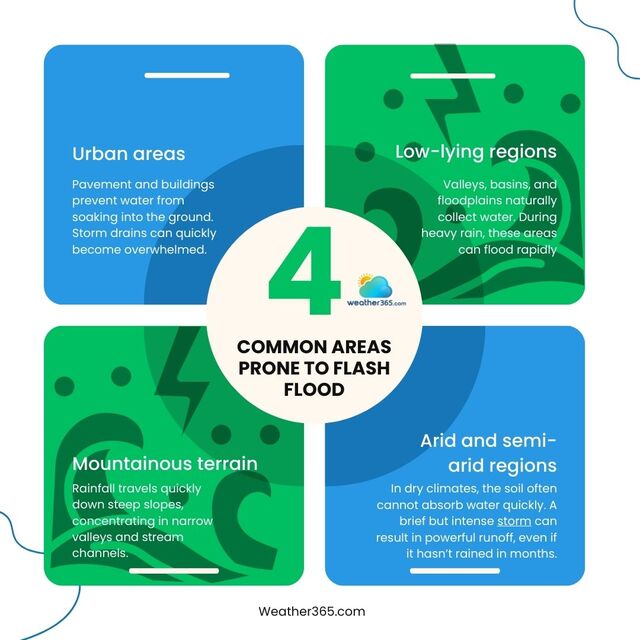
Areas prone to flood
Why are flash floods so dangerous?
Flash floods are especially dangerous because of their rapid onset and the limited time available for people to react.
Unlike regular river floods, which can take days or weeks to develop and allow for warnings and evacuations, flash floods can occur within minutes or hours after heavy rainfall or other triggers.
This suddenness makes it difficult to provide timely warnings, increasing the risk of casualties.
In Australia, floods are the second leading cause of natural hazard-related deaths, with 1,942 fatalities recorded between 1900 and 2022.
Although specific statistics for flash flood deaths are not available, many of these fatalities are likely linked to flash floods due to their sudden and intense nature.
Studies show that about half of flood-related deaths involve people attempting to walk or drive across flooded roads, bridges, or causeways, often trying to reach home during dangerous conditions. This behavior significantly raises the risk of drowning and injury.
The National Weather Service also emphasizes that flooding causes more deaths annually in the U.S. than other severe weather events like lightning, tornadoes, or hurricanes. ( Read more about the worst flood in US history)
-
Lightning – 41 deaths/year
-
Tornadoes – 68 deaths/year
-
Hurricanes – 45 deaths/year
-
Flooding – 88 deaths/year
Overall, the danger of flash floods lies in their immediacy, unpredictability, and the common underestimation of risk by individuals, especially when attempting to cross flooded areas.
Effective public awareness, timely warnings, and cautious behavior during heavy rain events are critical to reducing fatalities caused by flash floods.
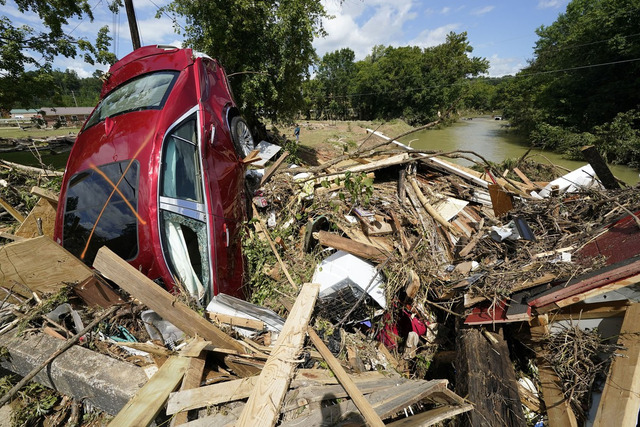
Flash floods have devastating power
Flash flood safety tips
Here are key flash flood safety tips based on expert guidance and official recommendations:
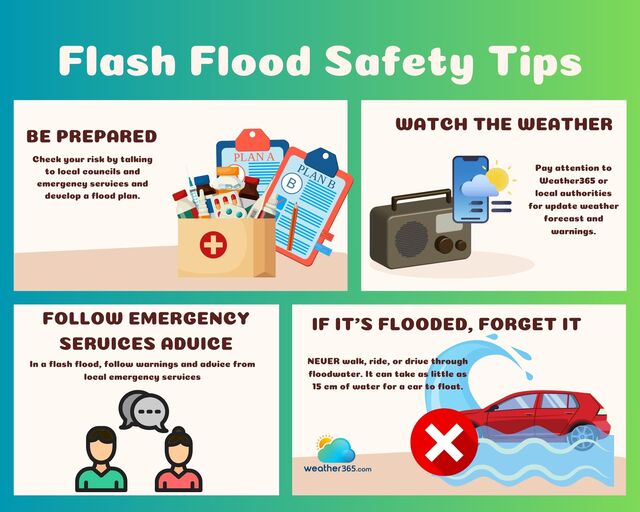
Tips to stay safe during a flash flood
Conclusion
You’ve learnt about “What is a flash flood?”, features, causes, as well as effects, and safety tips. Through this necessary information, hope you can stay calm and make a precise decision in the face of a flash flood.

0 Comment
Leave a comment
Your email address will not be published. Required fields are marked *